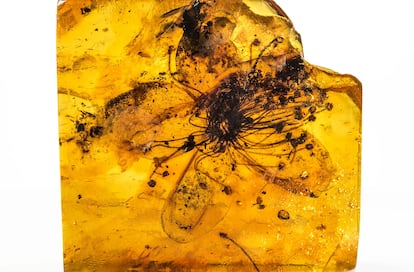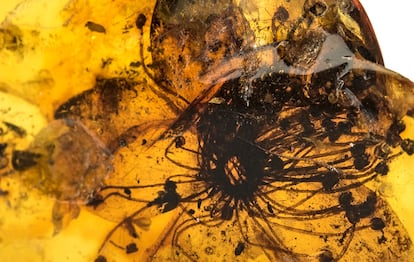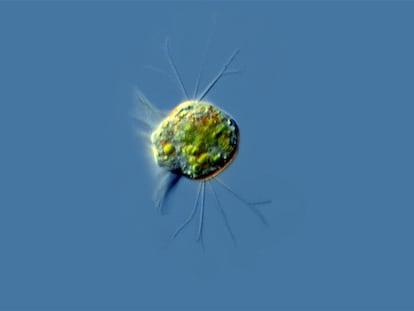Scientists identify the largest amber-preserved flower
The analysis of pollen from about 38 million years ago allowed researchers to correctly attribute the flowering plant, which was misidentified in the 19th century

One hundred and fifty years ago, a Prussian pharmacist named Kowalewski found a flower trapped in amber near a lagoon, in what is now the Kaliningrad Oblast region of Russia. Following the discovery, a botanist named Robert Caspary classified it, ultimately assigning the flower to the genus Stewartia, which contains about 20 different species of plants. Hence, the name it was given: Stewartia kowalewski.
Today, we now know that this was a misclassification. Two researchers – who rediscovered the specimen in a drawer at a Berlin scientific institute – have applied modern science to the flower. They have managed to date the specimen with relative accuracy, correctly identifying the type of plant family that the flower in amber actually belongs to.
The scientists have estimated that – due to its position in the geological substrate – S. kowalewski must have been surrounded by the resin of a tree between 34 and 38 million years ago. Impressively preserved, the flower maintains all its parts, including petals and pollen. It is not crushed or fossilized – amber has managed to preserve its original three dimensions.
With the help of a scalpel (and a lot of caution), researchers Eva-Maria Sadowski from the Museum of Natural History of Berlin and Christa-Charlotte Hofmann from the University of Vienna snatched a few grains of pollen from the resin within the amber. Their analysis – the results of which have been published in the scientific journal Scientific Reports – has led them to reclassify the specimen.

“We have been able to show that the specimen actually belongs to the Symplocos genus, which is a different family – the sweet leaf family,” Sadowski explains. The two women have now proposed that the flower be re-classified as Symplocos kowalewski. A correct identification will be a good starting point to understanding what the flower’s environment was like when it flourished millions of years ago.
Neither the Stewartia nor the Symplocos genera survive in Europe today. This means that, over 30 million years ago, the vegetation and climate must have been very different.
“Samples indicate that the family [Symplocos] thrives in mixed, moist forests, in warm temperate to subtropical climates, avoiding arid regions,” Sadowski says. Thanks to this flower – and the remains of other plants also trapped in amber – the authors of the study have been able to paint a landscape of this past “heterogeneous” northern European area, which included coastal swamps, marshes, riverside forests, and mixed forests of conifers and flowering plants, interspersed with open areas.
“Symplocos kowalewski probably grew in the wooded habitats of this amber forest, but it could also have been associated with swampy habitats,” says Sadowski.
The mystery that the researchers cannot solve is how such a large flower could have been preserved in such good condition. Almost all the flowers trapped in amber have a diameter of just a few millimeters – the rest have been preserved in broken pieces. But just the petals of S. kowalewski reach 28 millimeters. There are certainly older flowers that are preserved today, including some from 130 million years ag, but they’re tiny.
“The exceptional preservation [of the flower] could have been due to the resin that wrapped it,” Sadowski notes.
Researchers have tried to identify the origin of the amber without success. Apart from the coniferous trees present in the region when S. kowalewski flourished, there are few plant species that secrete resin that mineralizes and crystallizes in this way. And, as Sadowski suggests, “the original amber tree could be an extinct genus.” She also adds that “during the formation of amber, the resin changes its properties, so comparisons with existing resins are challenging.”
For the authors of the study, the preservation of the flower has only been possible due to the confluence of several factors. On the one hand – as they write in the study – “the exceptional conservation could have been caused by the biocidal properties of the resin that wrapped it, which would inhibit the degradation process.” The resin also could not have subjected the flower to excessive pressure, or it would have been crushed. In addition, the amber must have encapsulated the flower just at the moment of flowering. Otherwise, there would have been no pollen available to identify it today.
Sign up for our weekly newsletter to get more English-language news coverage from EL PAÍS USA Edition
Tu suscripción se está usando en otro dispositivo
¿Quieres añadir otro usuario a tu suscripción?
Si continúas leyendo en este dispositivo, no se podrá leer en el otro.
FlechaTu suscripción se está usando en otro dispositivo y solo puedes acceder a EL PAÍS desde un dispositivo a la vez.
Si quieres compartir tu cuenta, cambia tu suscripción a la modalidad Premium, así podrás añadir otro usuario. Cada uno accederá con su propia cuenta de email, lo que os permitirá personalizar vuestra experiencia en EL PAÍS.
¿Tienes una suscripción de empresa? Accede aquí para contratar más cuentas.
En el caso de no saber quién está usando tu cuenta, te recomendamos cambiar tu contraseña aquí.
Si decides continuar compartiendo tu cuenta, este mensaje se mostrará en tu dispositivo y en el de la otra persona que está usando tu cuenta de forma indefinida, afectando a tu experiencia de lectura. Puedes consultar aquí los términos y condiciones de la suscripción digital.











































